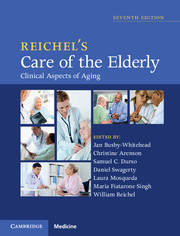Book contents
- Reichel’s Care of the Elderly
- Reichel’s Care of the Elderly
- Copyright page
- Contents
- Editorial Advisory Committee
- Contributors
- Acknowledgments
- Section I General approach to the care of the elderly
- Section II Geriatric syndromes
- Chapter 7 Frailty
- Chapter 8 Gait impairment and falls
- Chapter 9 Evaluation and management of dizziness
- Chapter 10 Evaluation and management of dementia
- Chapter 11 Recognition, management, and prevention of delirium
- Section III Care of the elderly by organ system
- Section IV Principles of care for the elderly
- Index
- Plate Section (PDF Only)
- References
Chapter 7 - Frailty
from Section II - Geriatric syndromes
Published online by Cambridge University Press: 05 June 2016
- Reichel’s Care of the Elderly
- Reichel’s Care of the Elderly
- Copyright page
- Contents
- Editorial Advisory Committee
- Contributors
- Acknowledgments
- Section I General approach to the care of the elderly
- Section II Geriatric syndromes
- Chapter 7 Frailty
- Chapter 8 Gait impairment and falls
- Chapter 9 Evaluation and management of dizziness
- Chapter 10 Evaluation and management of dementia
- Chapter 11 Recognition, management, and prevention of delirium
- Section III Care of the elderly by organ system
- Section IV Principles of care for the elderly
- Index
- Plate Section (PDF Only)
- References
Summary
- Type
- Chapter
- Information
- Reichel's Care of the ElderlyClinical Aspects of Aging, pp. 97 - 106Publisher: Cambridge University PressPrint publication year: 2016
References
References
Additional references
- 1
- Cited by



